It is difficult to deny the awesome beauty and grace of a white-tailed or other deer species. From their uncanny sense of smell to their astounding hearing, deer present a fascinating and awe-inspiring specimen of nature.
However, sometimes deer get a little too close, whether they’re chomping on azaleas in the landscape or destroying a field of corn or soybean. How can a farmer or homeowner keep deer away?
Most experts recommend a homemade deer repellant to keep these graceful animals at bay. Discover the most effective homemade deer repellants, from strategic planning, to scare tactics, to homemade spray concoctions.
1. Strategic Planting
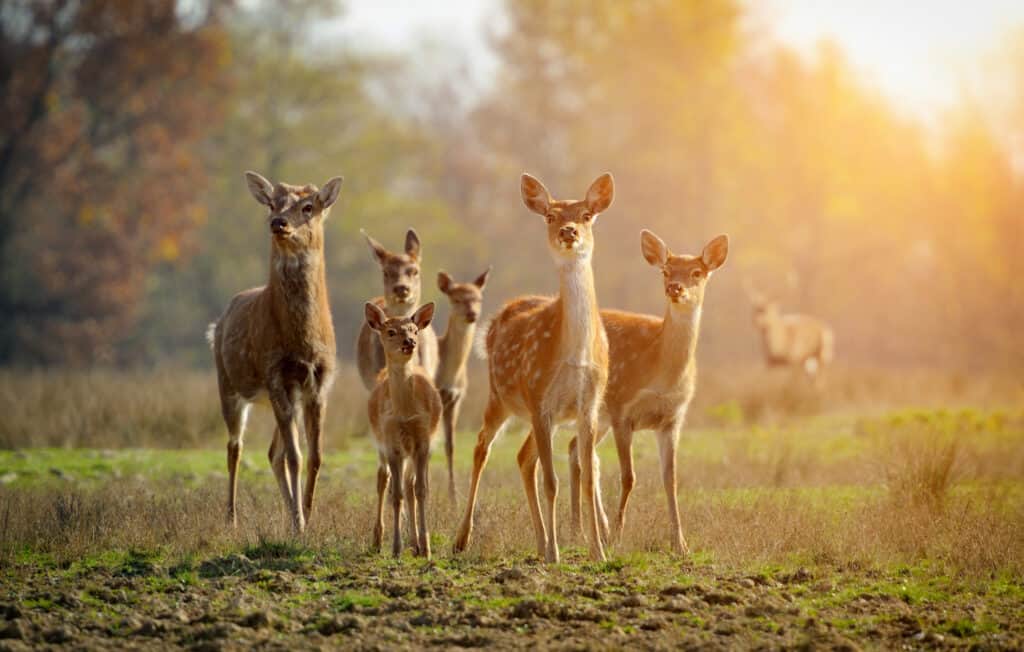
Deer primarily eat browse (wood and stems), forbs (broad-leafed plants), mast (acorns, apples, etc.), and grass.
©Volodymyr Burdiak/Shutterstock.com
One of the easiest ways to effectively repel deer from a landscape or garden is to strategically plant what deer despise. A deer’s smell receptors are incredibly acute, so targeting this sense makes, well, sense.
Many of the herbs humans use to flavor their foods are unpalatable to deer. Some aromatics that act as homemade deer repellents are sage, rosemary, oregano, mint, chives, thyme, and dill. Additionally, deer repellents include some lesser common herbs like lavender, catnip, germander, and lavender cotton.
In addition to herbs, deer are averse to many types of foliage. Gardeners and farmers enjoy success at repelling deer with sagebrush, wax myrtle, and fragrant sumac. As well, strong-smelling conifers such as junipers, cedars, and mugo pines also deter deer.
Deer also detest plants that feel prickly to their tongues. Choose garden plants such as lamb’s ear, lady’s mantle, Siberian bugloss, flowering tobacco, tuberous begonias, heliotrope, yarrow, poppies, and purple top vervain to keep deer away.
Plants with spiny leaves also discourage deer from destroying a landscape or garden. However, keep in mind that over time, deer will learn to graze around thorns to nibble on leaves. Manage deer damage by planting bear’s breeches, globe thistle, cardoon, and sea hollies.
2. Scare Tactics
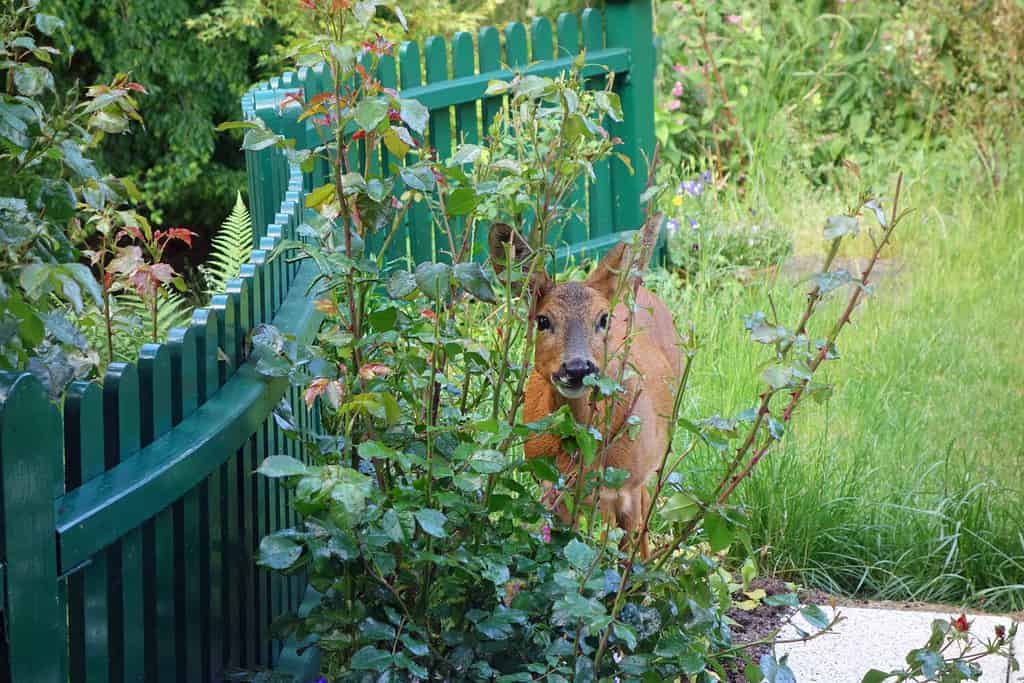
Utilize harmless scare tactics for homemade deer repellents to keep your garden safe.
©shutternelke/Shutterstock.com
Abrupt changes in the environment — whether it’s a human walking into a bedding ground or a sudden storm — drive deer to flee. A deer’s quick reaction to its environment is one of its chief survival skills, so use that deer instinct to your advantage. Most homeowners already own motion-activated sprinklers. A sprinkler’s sudden noise, spray, and movement not only scare deer away but also ward them off in the future.
Ultrasonic devices’ high-frequency noise will also alarm deer, but you can use a homemade version. A radio or other loud noise will generally keep deer away. Assuming you live where the wind blows frequently, wind chimes and mini windmills are also effective homemade deer repellents.
Finally, man’s best friend — your dog — serves as a major leverage for keeping deer away. Regardless of their breed or size, a dog’s bark and scent both send deer searching elsewhere for sustenance.
Scare tactics also include objects that you can place in your landscape or garden. Again, the unknown and unexpected make deer skittish. Craft some sort of scarecrow as a homemade deer repellent. This tactic could include traditional scarecrows or a decoy you may already have on hand, such as a plastic owl or other hunting bird.
3. Physical Barriers
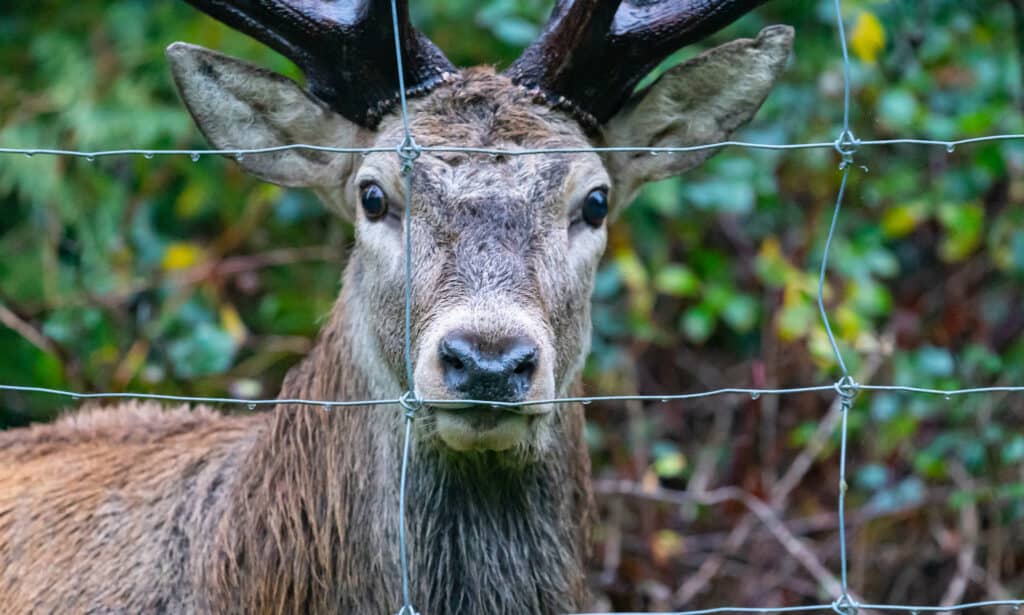
Physical barriers are effective homemade deer repellents.
©iStock.com/BrianScantlebury
Fencing is a great option for repelling deer, but they can be expensive and unsightly, depending on where they are located. For a foolproof fence, it must be eight feet high and contain a fairly tight-woven wire system. Additionally, netting materials form a physical barrier keeping deer away from precious plants and vegetables.
Another way to deter deer is to create a border around plant beds with fishing lines. For optimum effectiveness, string the line two to three feet above the ground and anchor it to wood or metal stakes. Pulled taut, the line, almost invisible, will confuse deer. The hope is that initially or eventually, the deer will become frustrated and give up.
An interesting alternative to fences is to create varying levels around your garden or landscape. If you’ve noticed, when you find a natural deer trail, it’s always the easiest path through whatever terrain it follows: “the path of least resistance.” Deer are smart and not inclined to climb when they do not need to. Therefore, creating elevated terraces or sunken beds can be an effective homemade deer repellant. Stacked chopped wood piles or wood palates make a perfect variance of elevation to keep out deer.
4. Homemade Mixtures
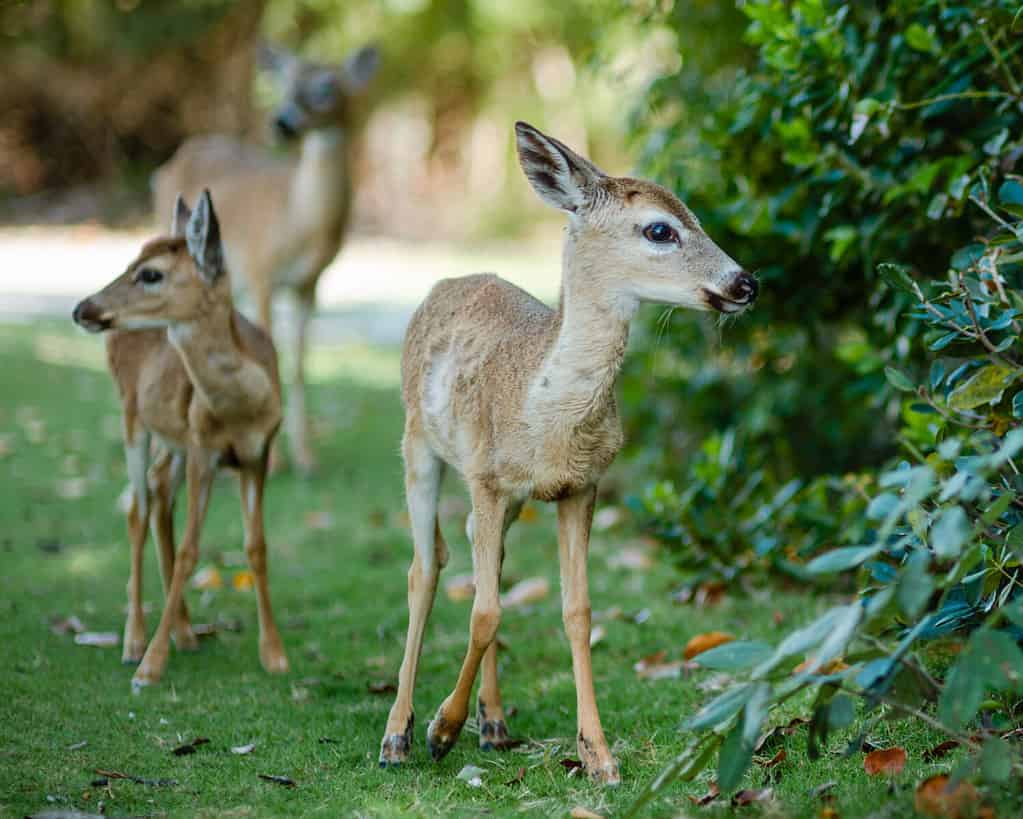
A multitude of different concoctions boasts effectiveness as a homemade deer repellent.
©Abigail Marie/Shutterstock.com
One of the most talked-about homemade deer repellents are mixtures comprised of both every day and sometimes bizarre liquid and powder mixtures.
The majority of humans are averse to extremely hot peppers and sauces. They don’t have the “hot pepper challenge” (also known as the ghost pepper or chili pepper challenge) for nothing. It makes sense, then, that deer do not care for hot substances like hot sauce or cayenne peppers. A mainstream homemade deer-repellent calls for about one part hot sauce to five parts water and perhaps one or two more ingredients that deer find abhorrent.
Another homemade concoction to repel deer is to use essential oils. The logic behind using essential oils is to mix together scents that deer find repugnant. Recipes vary, but most advise using rosemary, peppermint, lavender, clove, and cinnamon oils — 10 drops of oil total to one cup of white vinegar. Although not as commonly recommended, cedar, lemon, eucalyptus, and tea tree oils with the same ratio as white vinegar.
5. Dairy

Milk is an often-used homemade deer repellent.
©Chatham172/Shutterstock.com
Dairy products also provide a homemade deer repellant. Milk, sour cream, and yogurt, when left out in the elements, eventually sour. The logic is that the sour smell then clouds the deer’s sense of smell, thereby probing the deer to seek sustenance elsewhere. The repellant can be made with any type of milk — whole, two percent, skim, or buttermilk — but the goal is similar. It’s best to leave the milk out of the refrigerator for at least 24 hours.
Because smell is the impetus for the repellent here, the idea is to create the most disgusting, rancid smell possible. If the milk is curdled or too thick to transfer to a spray bottle, add a little water and/or put it into the blender first. Because milk contains casein, a sticky protein that helps it stick to leaves, a good coating of the milk repellent should last around 10 days, even with some rain. The only drawback to the milk mixture is that the same smell that repels the deer will also fill the humans’ nostrils.
6. Garlic
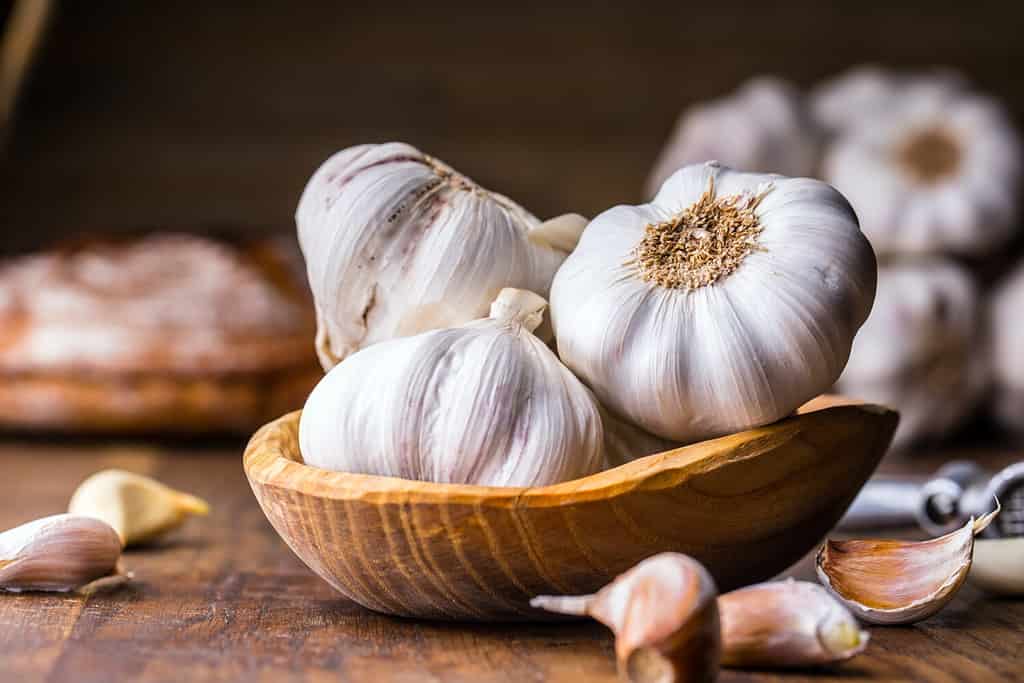
Garlic’s pungent odor repels deer.
©Marian Weyo/Shutterstock.com
Garlic not only (supposedly) wards off vampires, but it also deters deer from destroying your landscape or garden. If you plant garlic bulbs, you’ll not only repel pesky deer but also harvest a healthy aromatic for your Italian meatballs, soups, sauces, and other healthy meals. Just make sure to prune the plant regularly so that it continually emits the odor that deer find so repugnant.
If you don’t want to deal with planting the garlic, mix some garlic powder with water in a spray bottle to achieve a similar effect. Or, crush up some garlic cloves and distribute them onto your mulch and surrounding area.
7. Eggs

Eggs produce another smell that drives deer away.
©Cavan-Images/Shutterstock.com
It might seem kind of silly, but deer are afraid of the smell of rotting eggs. Because decaying eggs mimic the smell of decaying animals, deer naturally flee an area containing that smell to avoid possible predators. Most egg recipes call for using one to two eggs and water enough to fill a 16-ounce spray bottle. Some also advise adding a tablespoon or two of cooking oil to this particular mixture. As with any homemade deer repellent that uses odor to deter the deer, even though the concoction will be pungent to humans, the effect will last much longer and stronger for deer because of their acute sense of smell.
8. Human Hair

Using human hair is an economical way to make homemade deer repellent.
©fongbeerredhot/Shutterstock.com
It’s interesting to contrast deer in normal (woods, fields, farms, etc.) habitats versus deer that live in national parks and other areas where hunting is absolutely prohibited. My dog and I run into deer every morning on our walks, and even though we mean them no harm, the deer want as far away from us as possible. However, if we are in Cades Cove in the Great Smoky Mountains National Park, a grazing 10-point buck won’t even look up from his meal while dozens of tourists snap photos.
In their normal, non-protected habitat, deer are rightly afraid of human scent. It makes sense, then, that deer are afraid of the scent of human hair. If you cut your own hair at home, it’s a bit easier to collect hair clippings, but if you contact salons and/or barbershops in advance, most will be glad for you to take home some hair clippings. Sprinkle a barrier of hair clippings around your garden, or work it into the soil when you plant the bulbs.
9. Soap

Hanging a heavily scented bar of soap from a nearby tree can help deter deer.
©ScottyCo/iStock via Getty Images
Soap is a common household staple, and the stronger the scent the better to repel deer. You can distribute soap shavings throughout your landscape or garden. Also, put an entire bar of soap into a mesh bag, and hang it on a nearby tree or stake. Not only is soap a great deer deterrent, but it is also environmentally friendly and will not harm plants or animals.
10. Baby Formula

Baby formula offers a unique form of homemade deer repellent.
©MaraZe/Shutterstock.com
Similar to choosing milk as a deer repellent, baby formula is a newer and more interesting choice for deterring deer. Hydrolyzed Casein (HC) is a common ingredient in baby formula, especially formula made for colicky babies or those prone to milk allergies. In a study to evaluate the effectiveness of homemade deer repellents that contain Hydrolyzed Casein results revealed that formula with HC was as effective as the leading brand name, over-the-counter deer repellent.
So, what is the most effective homemade deer repellent?
Many of the above-mentioned repellents, especially the spray-on mixtures, utilize combinations of ingredients. For example, a recipe might call for hot sauce, garlic powder, liquid dish soap, and water. Another might mix a few essential oils with some soured milk and rotten eggs. The best advice is to experiment. Your particular region, the types of deer in that region, the makeup of your landscape and/or garden, and other numerous variables will determine which of these efficient homemade deer repellents is your best bet!
The photo featured at the top of this post is © SwedishStockPhotos/Shutterstock.com
Thank you for reading! Have some feedback for us? Contact the AZ Animals editorial team.







